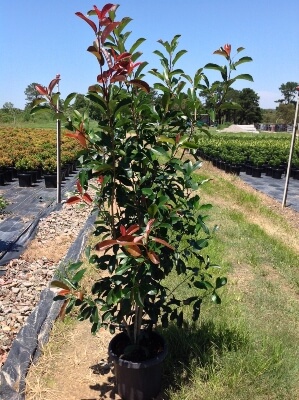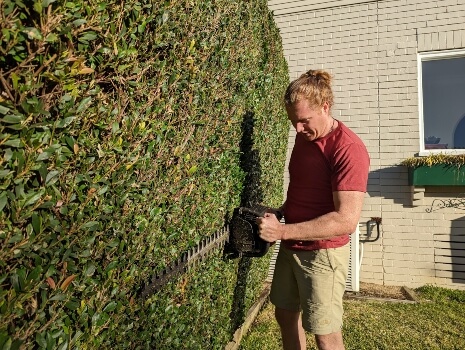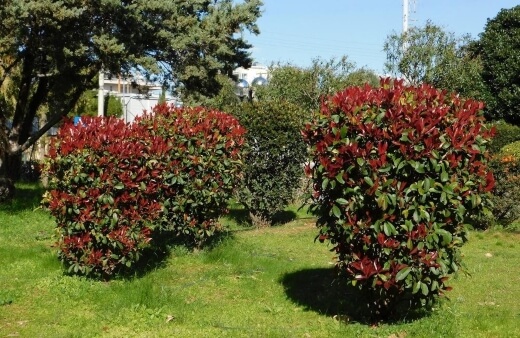If you’re considering establishing a hedge or looking for a brilliantly striking feature plant for your garden, Photinia robusta is a plant you shouldn’t disregard.
It is a widely cultivated hybrid cultivar that is a part of an already impressive genus, sporting delicate white flowers, crimson-red new growth and the perfect form for formal or relaxed hedging.
This plant is now adored throughout the world for its unparalleled ornamental and functional applications within landscapes. Here is everything you need to know to grow and care for this spectacular evergreen shrub in Australia.
More...

Nathan Schwartz of Aussie Green Thumb checking a Red Tip Photinia hedge
Grown mainly for its distinctive foliage and decorative fruits, this compact shrub can also be grown as a medium-sized tree as well. The foliage gleams with bright red young oval-shaped leaves that mature into a dark and glossy green.
Its upright growing habit is supported by a multi-trunked form, meaning this plant thickens easily and therefore makes for a fantastic, attractive hedging and screening candidate. The clusters of dainty white flowers in spring can also certainly impress.
Family: | Rosaceae |
|---|---|
Genus: | Photinia |
Hybrid: | Photinia × fraseri (Photinia glabra × Photinia serratifolia) |
Common Names: | Red tip photinia, Christmas berry |
Location: | Outdoor |
Type: | Evergreen shrub |
Growth: | 3 to 6 metres tall, 2 to 3 metres wide |
Sun requirements: | Full sun to part shade |
Foliage Colour: | Green |
Flower Colour: | White |
Flowering: | Spring |
Fruit: | Small red apple-shaped fruit in autumn (not edible) |
Maintenance level: | Low |
Poisonous for pets: | Non-toxic to cats and dogs |
Introducing Photinia Robusta
The photinia genus consists of roughly 40 to 60 species of small trees and large shrubs, most of which form a part of the rose family, Rosaceae. Common names for photinia robusta now include red tip photinia and Christmas berry.

The botanical name is derived from the Greek word ‘photeinos’ which means ‘shiny’, paying homage to the plant's brilliantly glossy leaves and bright new growth. This plant is also known as Photinia × fraseri, being a hybrid species of Photinia glabra & Photinia serratifolia.
Native to the warm temperate regions of Asia, India and Thailand, modern cultivars, including this plant, have been bred to grow in many different climates globally. A truly low-maintenance addition to the garden, this compact shrub is suitable for any grower.
Red Tip Photinia Growing Habits
Considered fast-growing in cultivation, this shrub grows to 3 to 6 metres tall and 2 to 3 metres wide depending on how you go about pruning. It is a very hardy plant that is considered one of the Big 5 for hedging and screening in many places.
The small flowers feature 5 rounded white petals and the highly decorative fruits will be adored by the local birdlife in your area.
Apart from its excellent hedging and screening applications, this plant can also be grown as a tree for use as a stand-alone feature specimen in your landscape where it can be trimmed to form attractive and colourful silhouettes in your natural spaces.
Most Popular Photinia × Fraseri Cultivars
Photinia ‘Little Red Robin’

Source: expoplant.com
A very compact and slower-growing variety, this plant is perfect for hedging at a 1-metre height. Featuring bright red new growth that matures into lime-green, this cultivar can truly add a great impact to your garden.


Get Your Free Guide:
Master Growing Australian Natives eBook
A Must Have Complete Guide for Every Australian Garden
Get Your Free Guide:
Master Growing Australian Natives eBook
A Must Have Complete Guide for Every Australian Garden
Its bushy growth can also be enjoyed as a feature rather than in groups. For it's close cultivar Photinia red robin, refer to our complete guide here.
Photinia ‘Robusta’

Source: andreasensgreen.com.au
Sharing the same brilliant new growth and gorgeously lush foliage as the little red robin, this cultivar differs due to its growing height, reaching 5 to 6 metres tall in cultivation.
Thanks to its larger size, blooming time will always be more impressive and widespread, giving growers a superbly ornamental shrub to work with.
Photinia ‘Pink Marble’

Source: landscapeplants.oregonstate.edu
As its name suggests, this special cultivar features even more colourful new growth that is borne in shades of blushing pink. Once matured, the foliage settles with a smooth green colour with creamy leaf tips.
While pruning is necessary for hedging, this cultivar can also look equally fantastic if left in its natural form. It grows to around 2 to 3 metres tall and wide.
How to Grow Red Tip Photinia
For these specific hybrid cultivars, purchasing young and healthy nursery plants is always more recommended. Seeds can be unreliable and, in many cases, leave growers with plants that are not true to form.
Be sure to check out your local nurseries or garden centres, either physically or online to find your healthy nursery plants.
Alternatively, if you have access to a disease-free parent plant, you can easily propagate Photinia robusta by using semi-woody cuttings taken in summer or winter.
Photinia Robusta Propagation Using Cuttings
- When pruning your plant or hedge, cut a few of the stem tips away that each have at least three to four nodes or segments.
- Prepare well-draining containers filled with a premium, loose propagating mix.
- Water lightly after setting the growing medium then plant the cut end of your cuttings into the containers.
- Place the cuttings in a well-lit and warm location away from any strong drafts.
- You should notice new root growth on the cuttings in only a few weeks.
- Once they have started to root, you can plant each cutting into its own growing container where it should spend another 12 months or so before being planted into the garden.
- Keep the soil lightly moist but never wet as your cuttings establish themselves.
Conditions & Tips for Planting Photinia Robusta

This hardy shrub can be planted anytime so long as you don’t live in a very cold climate, which not many Australians do. For the best results, plant young nursery plants or established cuttings in early spring just before the active growing season.
This will also ensure frost doesn’t harm your plants as young specimens can be sensitive.
Best Lighting for Christmas Berry
Full sun is preferred for these heavy flowering and fruiting plants but they can be grown in partial shade as well. They are even tolerant to more moderately shaded positions but foliage colour and growth may be stunted the more shade it gets.
At least 6 hours of direct sun each day should ensure healthy new growth, blooms and fruits.
Soil Requirements
Luckily, this hardy cultivar can tolerate a wide range of soil types as long as the soil is well-drained at all times. They do grow best in fertile, enriched soils that can retain moisture and stay well-drained at the same time.
A sandy or loamy soil should work great. For more clay-heavy soils, just add plenty of well-rotted compost or manure with some perlite before planting and dig that into your existing soil.
Photinia Robusta Hedging and Screening Tips

Nathan Schwartz of Aussie Green Thumb trimming a Red Tip Photinia
- Space each plant about 60 to 80 centimetres apart for a dense, quick-growing hedge or screen.
- For more formal hedging in larger spaces, plant about 1 to 1.5 metres apart. This will allow each shrub to grow and fill out more over time, eventually giving you a gorgeous and vibrant large hedge.
- Allow the shrubs to grow for about a full season before you begin trimming them back to create your hedge or screen shape.
- When trimming, be sure to also clip the top and sides of the hedge or screen to ensure it doesn’t get too wide.
- For the best, most tidy hedging results, trim your hedge throughout the growing season between spring and autumn, maybe every 4 to 6 weeks on average.
- For a more informal hedge or screen, trim back the top and leave the sides to grow more naturally.
- It is also often recommended to establish hedges in trenches rather than individual planting holes. This can make watering and feeding your hedge far more efficient and the planting process will also be far easier.
How to Care for Photinia Robusta
Once established, this plant is resistant to frost and can withstand temperatures from -5°C down to -10°C. Younger specimens may need some shelter from the cold and dry winds of winter though.
Overall, the plant will thrive and do its best in warmer conditions.

Pruning Red Tip Photinia
This shrub naturally responds very well to being pruned. Clip established plants throughout the year to continuously encourage new growth where you can then enjoy the repeating bright red show of colour in the new foliage.
This will also ensure the plants behave in a more orderly fashion. For general tidy-ups and a more natural appearance, prune once to twice a year.
For more flowers, avoid pruning in spring when the new buds are forming.
Watering Schedule
Water well and deeply until the plant is established. Thereafter, photinias will only need little water once established. Try to avoid letting the soil dry out but also be sure to not soak the ground too often.
Fertilising & Mulching Christmas Berry
Feed your plant or hedge annually in spring with a long-term slow-release fertiliser for prolific fruiting and flowering. Be sure to also add a healthy layer of organic mulch annually in springtime to help with moisture retention.
Mulch around the base of each plant, being sure to leave a gap between the mulch and the trunks.
Fruits & Clean-Up
As decorative and welcoming as the small apple-shaped red fruits may appear, they are not edible. Spent fruits will also eventually fall to the ground and will need to be cleared up.
As local birdlife feeds on the fruits, they can also make quite a mess of things. To avoid some fruiting, you can always cut back the flowers in summer before they mature.
Photinia Robusta Pests & Diseases
These hardy cultivars are mostly pest and disease free, especially when grown in healthy conditions. However, they can suffer from some of the same issues facing other members in the rose family.

Powdery Mildew/Leaf Spot
You can apply a general-purpose garden fungicide to get rid of these fungal issues. Good soil drainage, proper watering and some decent air circulation can also help in preventing these issues.
Cut away any leaves that have fungal spores on them and dispose of the affected foliage in your rubbish.
Scale Insects/Spider Mites
These smaller pest issues can become frustrating, especially in severe cases of infestation. Be sure to treat your shrubs as soon as you notice any signs of pests.
A horticultural spray or neem oil spray can be applied to quickly eradicate these infestations.
Photinia Robusta Frequently Asked Questions
How quickly does photinia robusta grow?
For a healthy growth rate, expect your plant to grow 3 to 4 metres every four years or so.
Are photinia robusta roots invasive?
It largely depends on the size of the specimen but the roots are generally far less invasive than other tree species. If you intend on establishing a larger feature plant, it may be best not to plant too close to structures or paving.
For hedging, the roots should grow compact in the soil and shouldn’t become invasive.
Does photinia robusta lose its leaves in winter?
Hard winters may cause the plant to lose its leaves just before spring. Luckily, this is about just when the growth will restart with its active season just ahead. Plants should bounce back quickly once their new growth begins.
In severe cases of leaf drop, you can boost the soil with some organic compost and fertiliser to encourage a faster recovery.
If you’re interested in establishing more native varieties that are also perfect for hedging and screening, be sure to check out our informative guides below:
Prop Up Your Garden’s Spectacle and Colour with Photinia Robusta
There aren’t many ornamental shrubs that can add such bright, intoxicating colour to gardens as this evergreen can. Being the perfect pick for hedging and screening, this plant will always impress with its crimson red new growth atop lush green foliage and its decorative fruits.
A very special and infamous cultivar in its genus, photinia robusta can be grown in most parts of Australia and is suited to all growers regardless of experience.
Published on August 2, 2022 by Maisie Blevins
Last Updated on February 22, 2024




